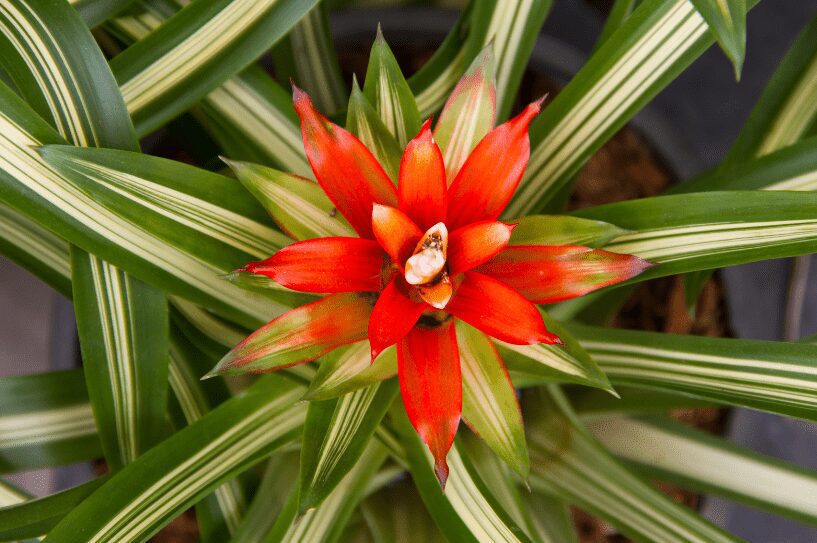
Looking to add a vibrant splash of the tropics to your indoor space? Bromeliad plants are the perfect choice! These unique beauties offer long-lasting color with minimal fuss, making them ideal for beginners and seasoned plant lovers.
What are Bromeliads?
Bromeliads are a fascinating family of tropical plants with over 3,000 different species. While they’re related to pineapples, most bromeliads aren’t grown for their fruit. Instead, they’re all about stunning foliage and those eye-catching, long-lasting flower-like formations called “bracts.”
Common Varieties Of Bromeliad Plants
Approximately 3,000 species of bromeliad exist. Bromeliads are distant cousins of pineapples, though bromeliads themselves aren’t edible.
Colorful house plants are more common, but some bromeliads are air plants, which take moisture from the air and use it for growth.
Tillandsia: Often called air plants, these are a type of bromeliad, though some grow in soil.
The plants look like spiky green stars with lots of layers, and range in size, although most can fit in your palm.
It is one of the few types of bromeliads that like direct sunlight and frequent misting. Some produce flowers.
Guzmania: The most well-known bromeliad, Guzmania is distinguished by its vibrant bracts, which are often orange, red, or yellow, and its simple maintenance requirements.
It is highly improbable to flower; even if it does, the flower won’t be very tall compared to the bracts.
Vriseas: Vriseas are known as “blazing swords” because of their striking geometric orange and yellow bracts. As Vriseas approaches the end of its lifespan, it may only ever blossom once.
Neoregilia: These have much stiffer bracts and a small amount of spike on edge. From vibrant pink to dark brown, the colors are varied. Small flowers could sprout from the cup’s base if you’re fortunate.
Cryptanthus: These resemble other potted green plants more closely and are sometimes called earth stars. Their leaves, which can be pink, red, or forest green, develop in a rosette shape.
Tillandsia Religiosa: Christmas displays often include this plant. Mexico celebrates the holiday; they call this plant “Bromada,” particularly in Sierra de Tepoztlan, Tlayacapan, San Jose de Los Laureles, and Tepoztlan.
Science discovered an entirely new species of bromeliad plant. It grows up to 5 ft and is found in rocky habitats in northern Morelos. They flower between December and March.
Plant Profile
Botanical name: Bromeliaceae
Commonly known as Bromeliads
Hardiness zone: 9-11
Toxicity: Not toxic to humans or pets
Caring for Your Bromeliad
Bromeliads are remarkably low-maintenance. Here’s the lowdown:
- Light: Most bromeliads thrive in bright, indirect light. Think near an east or south-facing window, sheltered from the harsh midday sun.
- Watering: The secret is less is more! Water sparingly, about once every 1-2 weeks, allowing the soil to dry out slightly between waterings. Focus on filling the central cup of the plant.
- Humidity: Bromeliads love a humid environment. Mist them a few times a week, or use a humidifier if your home is dry.
- Temperature: Keep your bromeliad comfortable between 60-80°F (15-27°C).
- Fertilizer: A diluted, balanced liquid fertilizer applied monthly during spring and summer can boost your bromeliad.
- Potting: Use a well-draining potting mix, like orchid mix, and a pot with drainage holes. Bromeliads have shallow roots, so a smaller pot is often fine.
Troubleshooting Tips
- Brown leaf tips: Usually a sign of low humidity or underwatering. Increase misting and check soil moisture more often.
- Overwatering: Leads to root rot. If your plant is tilting, the roots might be damaged. Reduce watering immediately.
- Pests: Watch out for mealybugs and scale. Check your plant regularly and treat infestations promptly with a gentle insecticidal soap.
Beyond the Basics
- Propagation: Bromeliads reproduce by forming “pups” at their base. Wait until the pups are about 1/3 the size of the mother plant, then carefully separate and repot.
- Landscaping: Some bromeliads can thrive outdoors in warmer climates, adding a touch of the tropics to your garden.
- Air purifiers: Bromeliads naturally help purify the air, making them a healthy addition to your home.
Bromeliads: Effortless Beauty
With their captivating colors, easy care, and fascinating variety, bromeliads are sure to brighten your space. Whether you’re a plant newbie or an experienced grower, there’s a perfect bromeliad waiting to add a touch of tropical paradise to your life!
Final Word
- Bromeliads are colorful, beginner-friendly houseplants.
- Although numerous varieties of bromeliads exist, guzmanias are the most prevalent and straightforward.
- Make sure to give bromeliad plenty of humidity and moderate, indirect light.
- Bromeliads make excellent houseplants for novice plant parents or those who enjoy vibrant colors.
- There are various varieties, but a Guzmania will likely be the most user-friendly if you’re just starting.
- Be careful to provide humidity and mild, indirect light; water it only when the soil is dry.
Last update on 2024-07-26 / Affiliate links / Images from Amazon Product Advertising API























